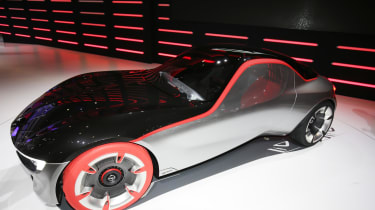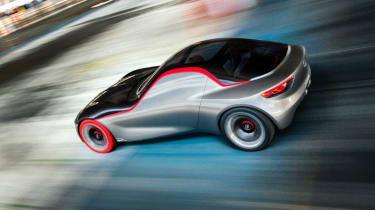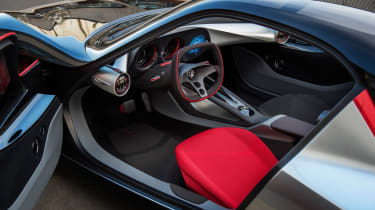Vauxhall GT coupe concept - new photos from the Geneva motor show
No production plans, but Opel and Vauxhall's concept promises a sub-1000kg kerb weight and rear-wheel drive
Previewed in the run-up to the 2016 Geneva motor show, Opel and Vauxhall’s GT Concept is undoubtedly one of the stars of this year’s show.
Details are deliberately scarce, with no commitment from the companies to put the car into production, but the details we do have are enticing: The GT is front-engined, rear wheel drive, lightweight and incredibly compact – with a smaller footprint than a Corsa.
At 3.85 metres long, 1.68m wide and 1.18m tall, it’s shorter, narrower and lower than a Mazda MX-5, but features a fixed roof and an ultra-low bonnet line that gives the GT even more dramatic proportions than Mazda’s roadster.
While the car is inspired by Opel’s original GT sports car, designer Mark Adams is adamant the new GT is not a retro design.
‘The original was a fantastic design and represented the spirit of the 1960s’ he said at a pre-show unveiling of the car. ‘We wanted to bring that spirit into 2016, but do it in a progressive, modern way.’
To that end, Opel has ensured the new car is compact – also a feature of the original – and with a 1-litre, 3-cylinder turbocharged engine, simple forms and sub-1000kg kerb weight, it also echoes the original’s approachability and attainability.
There are flourishes – the red front tyres reference those of the 1920s Opel Motoclub 500 motorcycle, and the wheels they’re mounted on have a ‘roller-skate’ design – but overall the GT is an incredible simple shape.
‘There are no big, open, gaping holes to show performance’ says Adams. ‘The key to emphasising the car’s simplicity is the red line running through the car – your eye travels along this line, which makes the car look longer and lower. It has a relaxed stance, to communicate that it’s a rear-wheel drive vehicle.’
That red motif also has practical purposes: by curving into the roofline, the huge doors – which pivot half way between the front wheel arch and where a traditional door cut-line might be – allow you to step down into the car, rather than feeding yourself in through a narrow opening.
Once inside, the simplified cabin is more spacious than you might expect too. That’s partly down to the clever seamless transition between bodywork and side windows. With no distinct separation between door and glass, the window is much deeper than you might expect. From the driver’s seat, the raised front fenders peak above the wheels, so you can see the corners of the car.
A single dashboard element spans the cabin, carrying small round screens at its extremities – that show images from side-mounted cameras – and an instrument panel that Adams calls ‘a single-piece sculptural object’.
Displays are back-projected and while the two instrument binnacles suggest a separate tachometer and speedometer, the two are actually combined in one. ‘The speedo and rev counter are in one dial,’ explains Adams, ‘with the speedo on the back surface, while the rev counter comes out through the tube.’
The engine develops 143bhp and 151lb ft of torque, and while a manual transmission might be the default choice for a small sports car like this, Opel has chosen to use a six-speed sequential with steering wheel-mounted paddles.
The 0-62mph dash takes ‘less than eight seconds’, with a 134mph top speed – both figures perfectly competitive with the MX-5.
That Opel and Vauxhall have no plans to turn the car into a production model is a shame, but perfectly understandable – GM has no lightweight, inexpensive rear-drive platform in its portfolio.
But as the compact sports car market expands – with Fiat and Abarth 124 joining MX-5, Subaru BRZ and Toyota GT86, and Toyota’s S-FR potentially on the way – the case for its creation becomes ever stronger.
Check out all the latest production cars, concepts and videos on our Geneva motor show hub page.









